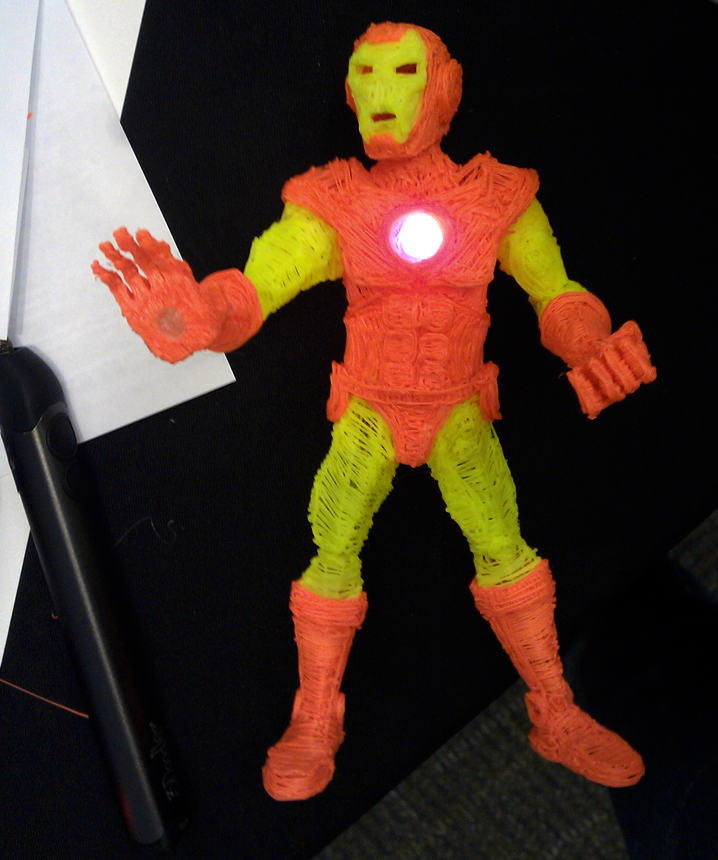The four-day long SXSW Edu series is a component of the South by Southwest family of conferences that – through workshops, an expo, and films – emphasizes creativity in teaching and learning method. And, because it precedes SXSW Interactive, it offers an excellent chance to get some SXSW experience, without the same crowding or exorbitant hotel pricing.
There is an area of Edu called “The Playground” and proponents of this area emphasize hands-on learning approaches, as well as live workshop elements. On display at The Playground was the 3Doodler 2.0, where I had the opportunity to interact with the people at their booth and to try out the 3Doodler 2.0.
The 3Doodler started as a Kickstarter project, with which they were quite successful and achieved their requisite funding. Since then, the inventors have been working to make the 2.0 a more complete realization of their original intents, ultimately launching a second Kickstarter just as successful as the first. According to the start-up’s folklore, the idea for the 3Doodler was born when Peter Dilworth and Maxwell Bogue were inspired by a 3D printer that was being obnoxious. They wished that they could just take off the printhead and work with it directly. Boom. Inspiration. Sources say that the other printer trembled anthropomorphically as it considered the ramifications of this inspiration.
The 2.0 is an impressive little piece of work. This pen has a sleek design. The body is compact, sturdy, but quite easy to wield. It is charcoal grey with black accents and a whimsically cursive “3Doodler” logo. It is about the same length as a regular pen and maybe twice the width. The overall shape is an extruded, filleted, triangular prism.
The nozzle is brass and cleanly designed. There are two buttons that control extrusion settings. One click to extrude, two clicks switch the pen into a “continuous extrude” mode, in which the pen will extrude endlessly until the buttons are held down to halt extrusion. The “continuous extrude” feature is new to the 2.0 and is very useful for larger or more complicated projects, as one’s thumb could get quite tired of holding down its buttons. Other improvements include more reliable extrusion, clog reduction, and improved overall function.
The presence of 3Doodler at SXSW Edu was intended to promote their Edu Bundle, which offers schools and educators a discount on a dozen pens and various accoutrements. The Bundle was inspired by a recent pilot project at St. Augustine’s in Redditch, Worcestershire, England, where benefits to using the 3Doodler were demonstrated in an academic setting. According to the case study, the pen can “enhance the performance of divergent thinkers,” “improve concentration amongst students, including those with ADHD,” and “level the playing field between male and female students, especially in the sciences.” These results has made the start-up want to get the 3Doodler out into the hands of educators to see what kind of educational shenanigans might emerge.
While at the event, an artist at the booth mesmerized a crowd with the full gamut of the tool’s usefulness. One of the original backers of the 3Doodler on Kickstarter, Louis DeRosa is now an official artist for the company and was out at the MoMA store in New York showing off the pen, as well as their booth at CES. With a background in animation, he immediately recognized the versatile potential of the product saying, “When I first got the 3Doodler, I wanted to use it like a regular 3D printer, building up a layer at a time, but I soon realized that 3D printers have to work that way. With the 3Doodler, you’re free to work on whatever part of your creation you want without being limited to working from the bottom up.” He demonstrates this quite well, by making a small Technicolor Iron Man, complete with a tiny light fused in the chest cavity and covered with a thin layer of translucent PLA filament.
The filaments used by the 3Doodler further separates this particular pen from others on the market. Firstly, users have to use these specific filaments (straight sticks of ABS or PLA) because repurposing the rounded filament of desktop 3D printers strains the little tool. These filaments are made from only US- or UK-sourced plastics, because of the higher safety standards demanded by this sort of usage. The ABS bonds slightly better to itself and the PLA has a slightly sweet smell and will eventually biodegrade.
The 3Doodler seemed to succeed at sparking the imagination of SXSW attendees. Several people who work at schools for the visually impaired expressed interest in using the pen to create tactile learning aids. A woman with a dyslexic son expressed a similar intent. A man with a science show on YouTube expressed an eagerness to use the pen to illustrate and emphasize what he teaches – his fondness for 3D printing technology having been previously enhanced by the part it played in his girlfriend’s brain surgery. A wandering neuroscientist mused that this pen would yield an excellent replica of what he considered the most beautiful neuron. A lady who had acquired a pirate Lego minifig from a neighboring booth wanted to see if the 3Doodler could be used to draw grey hair on the pirate to make it female. The end result was slightly more like an awesome George Washington. Still, the creative intent was expressed.
The 3Doodler came to SXSW Edu to engage educators and learners in finding ways to connect their 3D printing pen with creativity. It appears they succeeded at that intent. Tools are an extension of the human mind, another way to bring thought to reality. A tool that serves that purpose is worthy of consideration.
I believe tiny plastic Iron Man guarding tiny plastic Sydney Opera House would agree with me.






